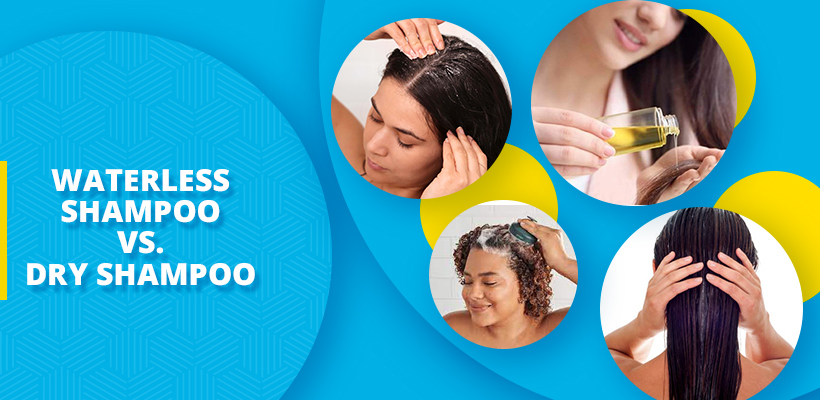Waterless and dry shampoos are some recent formulations in markets which attract customers due to its sustainable use and many beauty experts recommend washing your hair less frequently to keep it healthy. Consumers’ concerns about water scarcity and ever-changing lifestyles are the driving force behind the growth of these hair care products.
Many beauty and cosmetology courses focus on hands-on skill development through dedicated practical lab sessions to meet this growing demand for innovative products. Such products are especially beneficial to people who travel frequently and need to carry essential toiletries or don’t get time to wash their hair frequently in which shampoo has become an essential part of hair care routine.
What is the difference between Waterless Shampoos and Dry Shampoo?
Waterless Cleansing Foam– It works on normal and dry hair. When your hair is less oily, regular, and not necessarily dried, then you can use waterless cleansing foam. Waterless cleansing foam relaxes the hair and makes it soft and curlier. It could refresh the texture and moisturise your scalps and give a subtle hand-feel. Proper application of the waterless cleansing foam will glitter the hair strands and soften the hair. We can take foam on hand and apply it to hair following circular motion before the product condenses. Need to blend product properly into hairs so as to soften hair afterwards.
Dry Shampoos- Dry shampoo doesn’t use water. It removes messy grease and odours and oil from the hair like a regular shampoo. From the hair; need to apply it without use of water. Your hair has to be oily and messy to consider using dry shampoo. Some people complain that it can leave a white residue. It is necessary to perfect such products as per customer demand, which is why many beauty cosmetology colleges in Nashik train students to become skilled formulators and work in the beauty industry to close the gap between customers and industry.
If you’re looking for a natural alternative to commercial dry shampoos, you can buy organic dry shampoos, which are made from all-natural ingredients. Cornstarch or baby powder as their main ingredient. Normally, it is sprayed onto the hair’s root, or if it’s in powder or liquid form, it is advised to massage it into the scalp. Be sure to spray the dry shampoo 4-6 inches away from the scalp. Blending the product in with your fingertips will help to sponge up the oils. Use a comb or brush to distribute the product evenly.
Composition
A Diploma in Cosmetology will go a long way in helping you understand the role product composition plays in ensuring its efficiency. Dry shampoo is generally composed of a carrier agent containing an active powder. Starch normally used as the active powder. When the powder is sprayed onto hair, the carrier agent evaporates while the starch remains attached. The active powder can be replaced with other substances such as activated carbon and alumina; these substances are generally not used due to their inability to biodegrade. Activated carbon and alumina leave behind a residue that is difficult to remove.
What Makes it so Sustainable and Clean?
It is free of water. Considering the water shortage recently we’re facing, according to the World Health Organisation, half of the world’s population will be living in water-stressed areas by the year 2025. To cut back on water, water-free cosmetics have recently emerged in the green beauty technology, with global brands and younger companies like to reduce their water footprint and creating completely waterless formulas. But it’s also free of your standard list of harmful ingredients, including sulphates, parabens, silicones, and artificial colours and fragrance.
What are the Benefits?
The main benefit of waterless shampoo (besides saving the planet) is that you’re actually getting a more concentrated hair product. A waterless formula increases the efficacy because you are getting what you really need rather than a water-diluted mixture. We know that water is a breeding ground for bacteria; so many traditional shampoo brands add extra ingredients in order to increase shelf-stability of products. When you eliminate water, you also eliminate the need for those extra life-extending chemicals.
What are the Side Effects?
White residue on scalp due to over deposition of dry shampoo. Fungal growth from the buildup of chemical powders and pollutants. Hair loss from inflamed hair follicle due to blockage. Talc is often present in dry shampoos as an absorbent which can lead to respiratory issues. There is often the use of fragrances in dry shampoos which may cause allergies or sensitivities.
Nausea caused by liquefied petroleum gas. Hormone imbalance resulting from the inclusion of parabens as a preservative. Eye irritations due to the product accidentally be administered to the eye. Dermatitis caused by fragrances and potential metals from dry shampoo. The product is flammable if it contains butane, isobutene, or propane in the spray propellant.
Conclusion
Waterless and dry shampoos both have their benefits and drawbacks. At the end of the day, it boils down to customer preference and need. If you are genuinely interested in pursuing a career in beauty cosmetology then you may want to check such courses out and see which matches your career goals the best. The course curriculum of leading cosmetology courses in Nashik has been designed bearing in mind the current and future needs of the cosmetic industry. So find out more about such programs to make an informed decision regarding your career.

